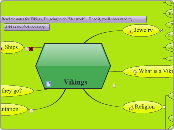rThere were two distinct classes of Viking ships: the longship (sometimes erroneously called "drakkar", a corruption of "dragon" in Norse) and the knarr. The longship, intended for warfare and exploration, was designed for speed and agility, and was equipped with oars to complement the sail as well as making it able to navigate independently of the wind. The longship had a long and narrow hull, as well as a shallow draft, in order to facilitate landings and troop deployments in shallow water. The knarr was a dedicated merchant vessel designed to carry cargo. It was designed with a broader hull, deeper draft and limited number of oars (used primarily to maneuver in harbors and similar situations). One Viking innovation was the beitass, a spar mounted to the sail that allowed their ships to sail effectively against the wind.Longships were used extensively by the Leidang, the Scandinavian defense fleets. The term "Viking ships" has entered common usage, however, possibly because of its romantic associations (discussed below).In Roskilde are the well-preserved remains of five ships, excavated from nearby Roskilde Fjord in the late 1960s. The ships were scuttled there in the 11th century to block a navigation channel, thus protecting the city, which was then the Danish capital, from seaborne assault. These five ships represent the two distinct classes of Viking ships, the longship and the knarr. The remains of these ships can be found on display at the Viking Ship Museum in Roskilde.Longships are not to be confused with later-period longboats. It was common for Viking ships to tow or carry a smaller boat to transfer crews and cargo from the ship to shore, however.
